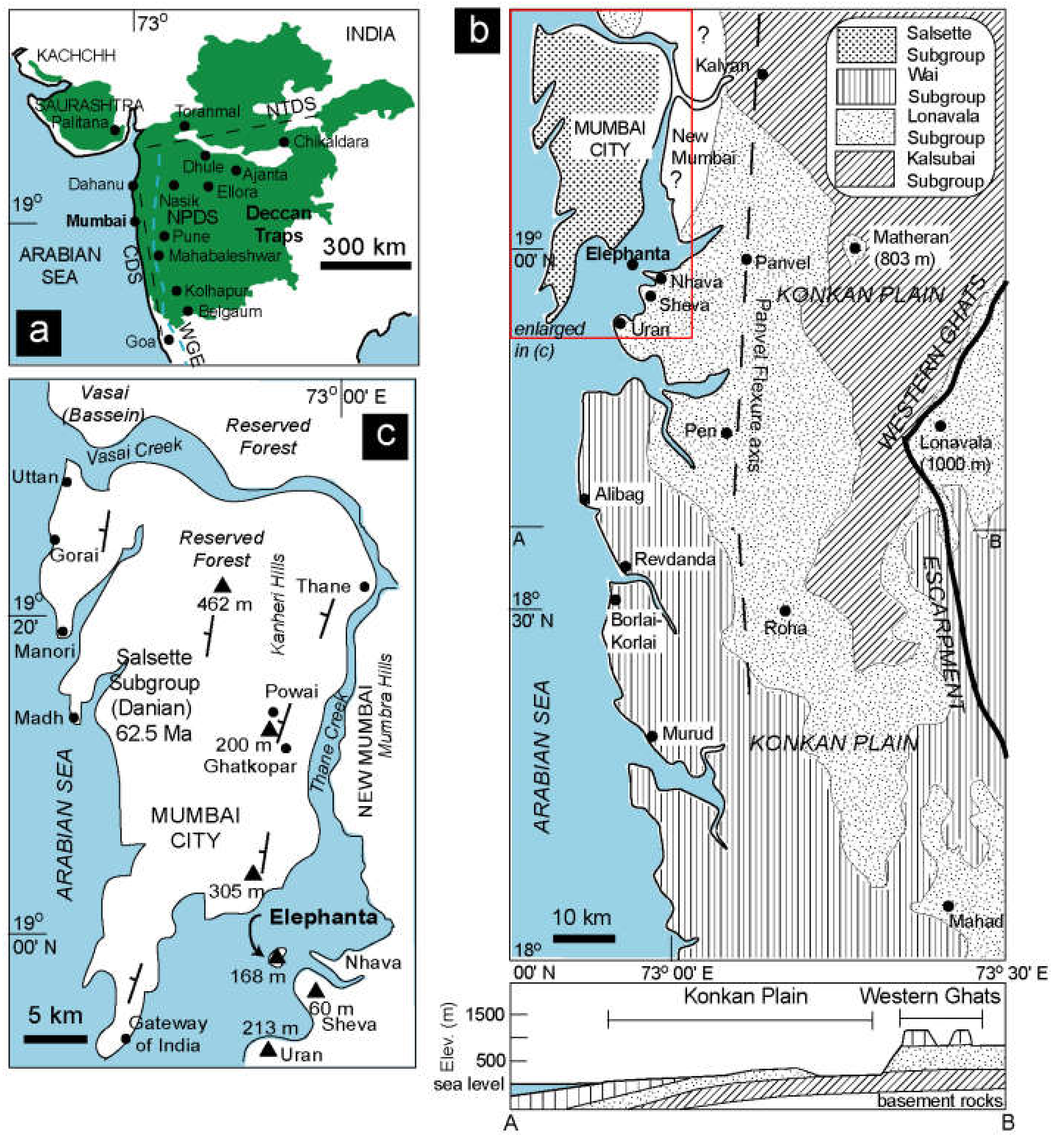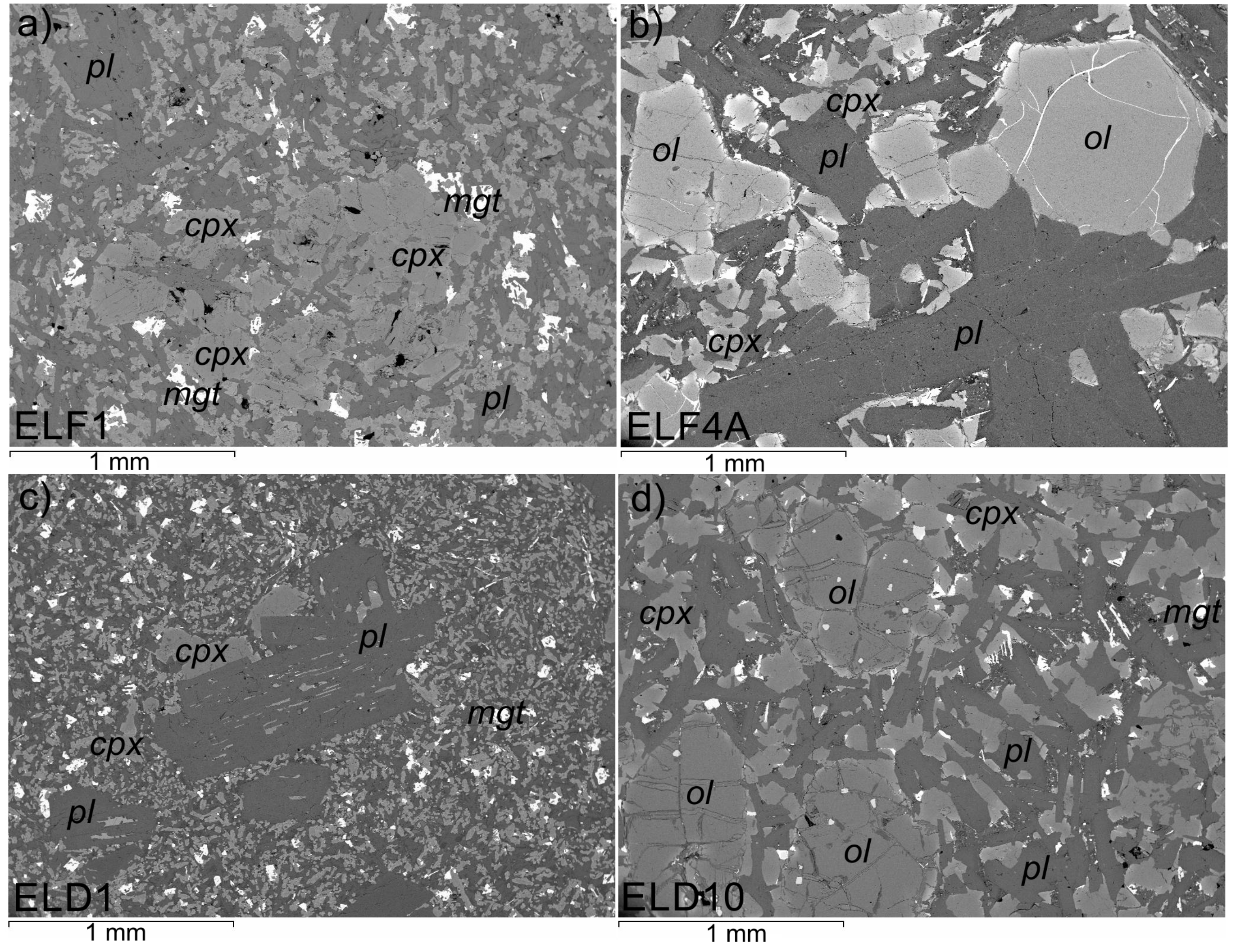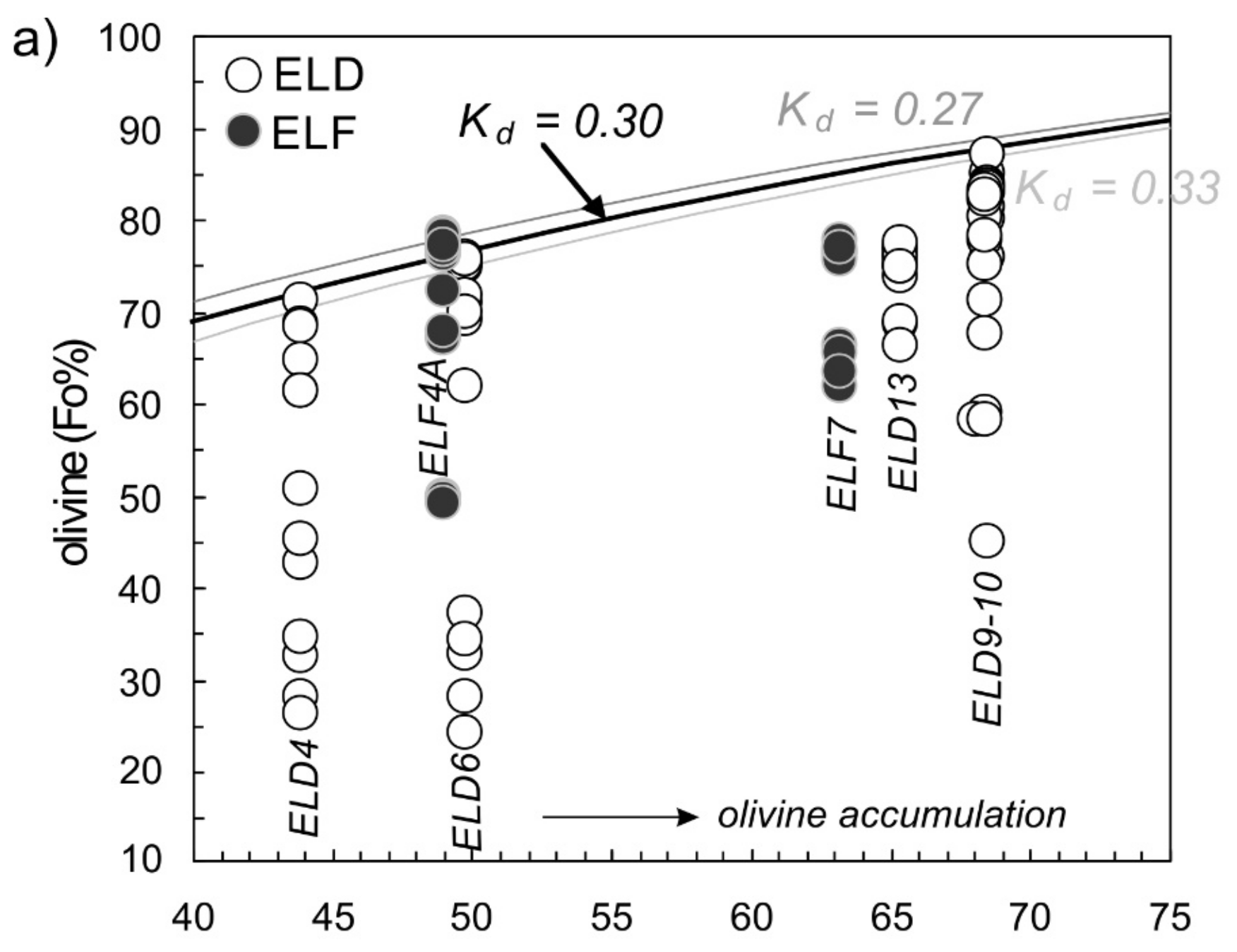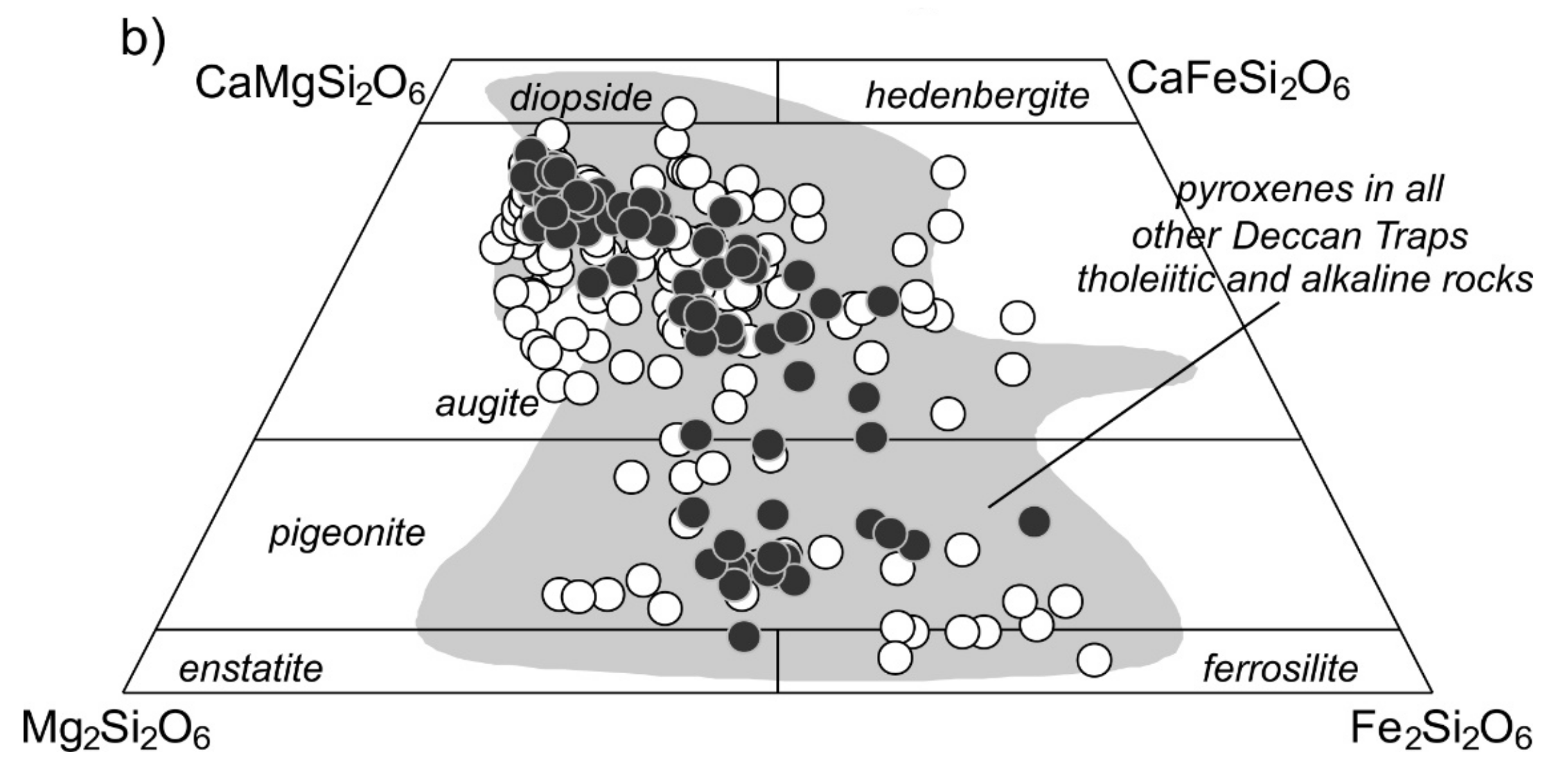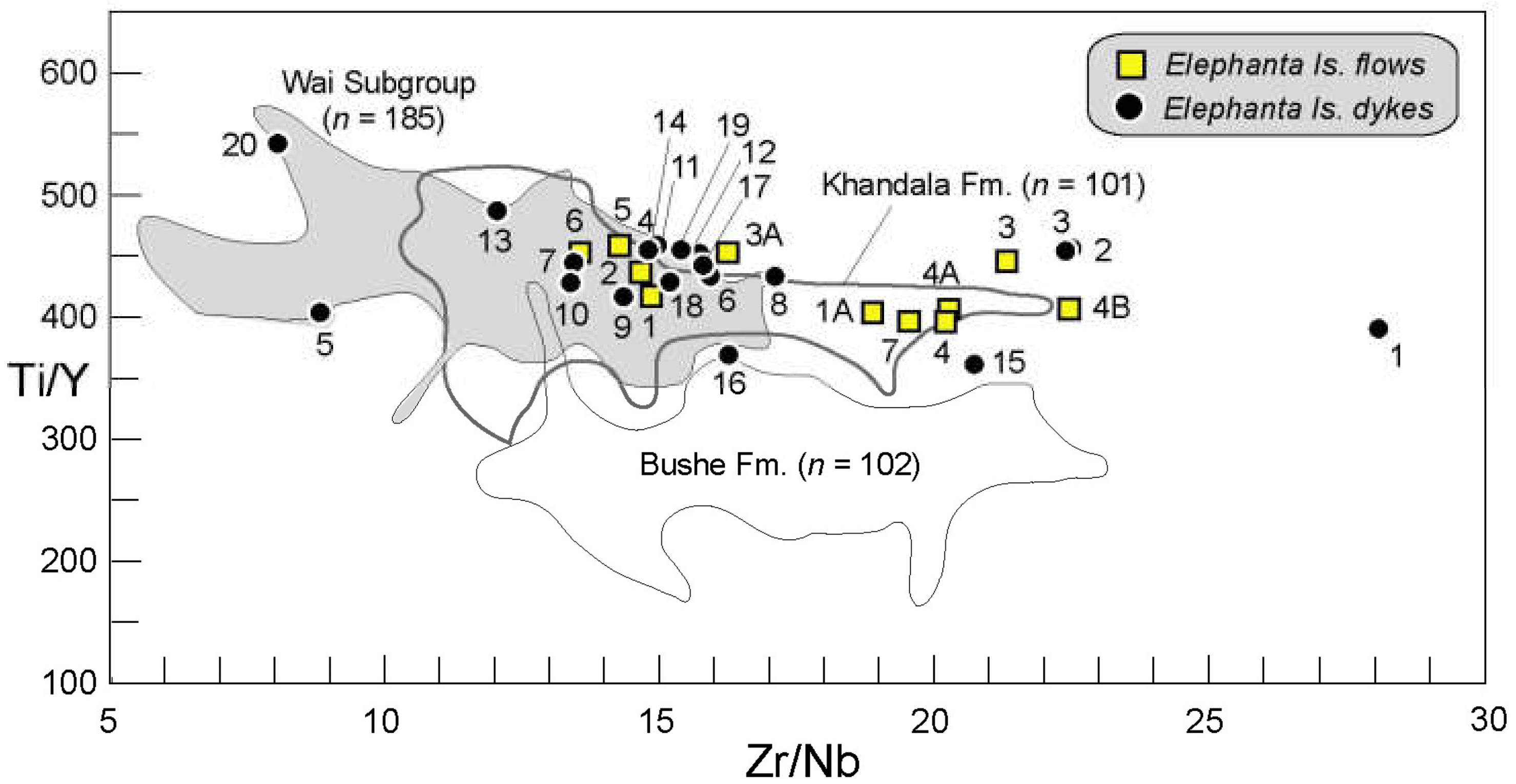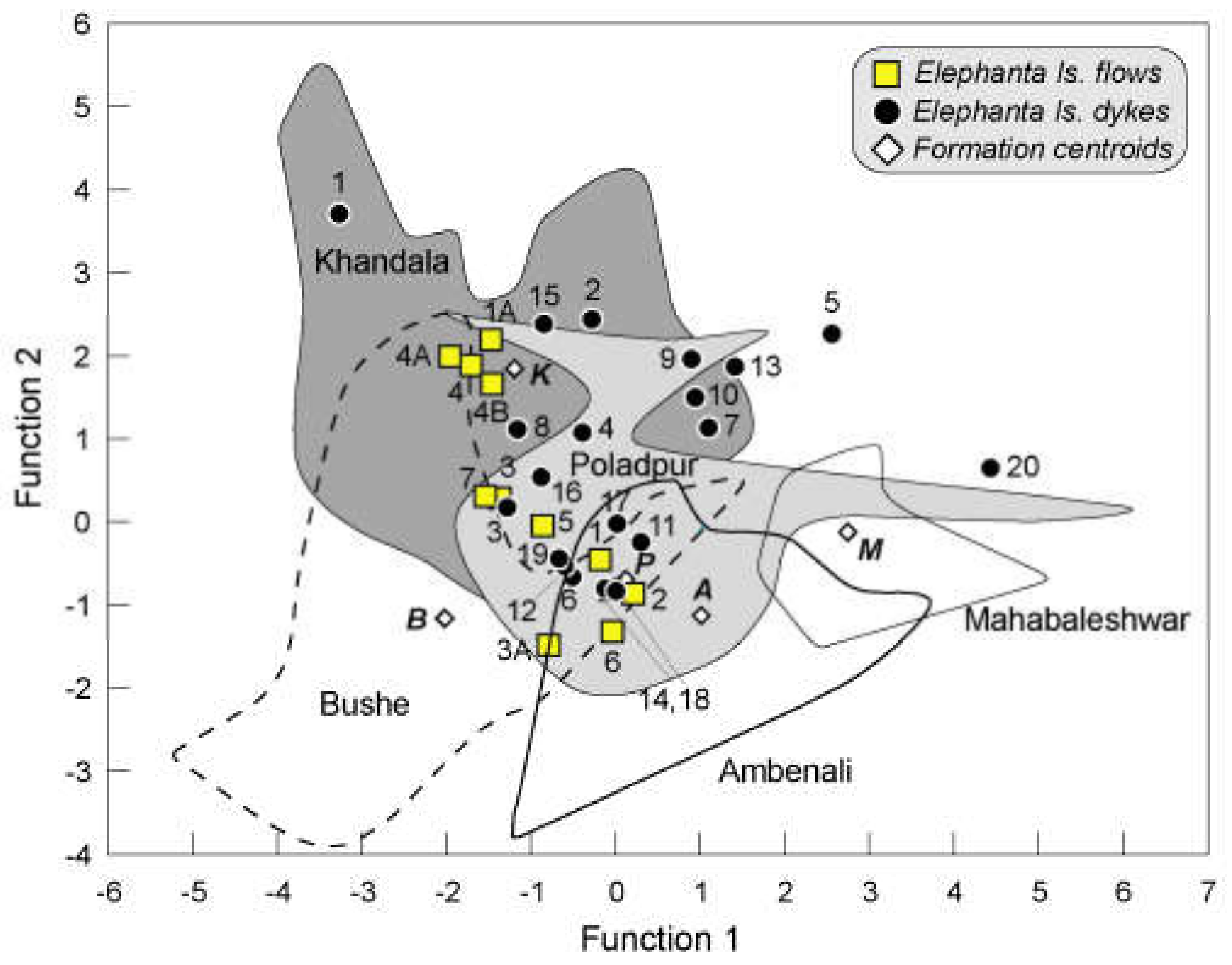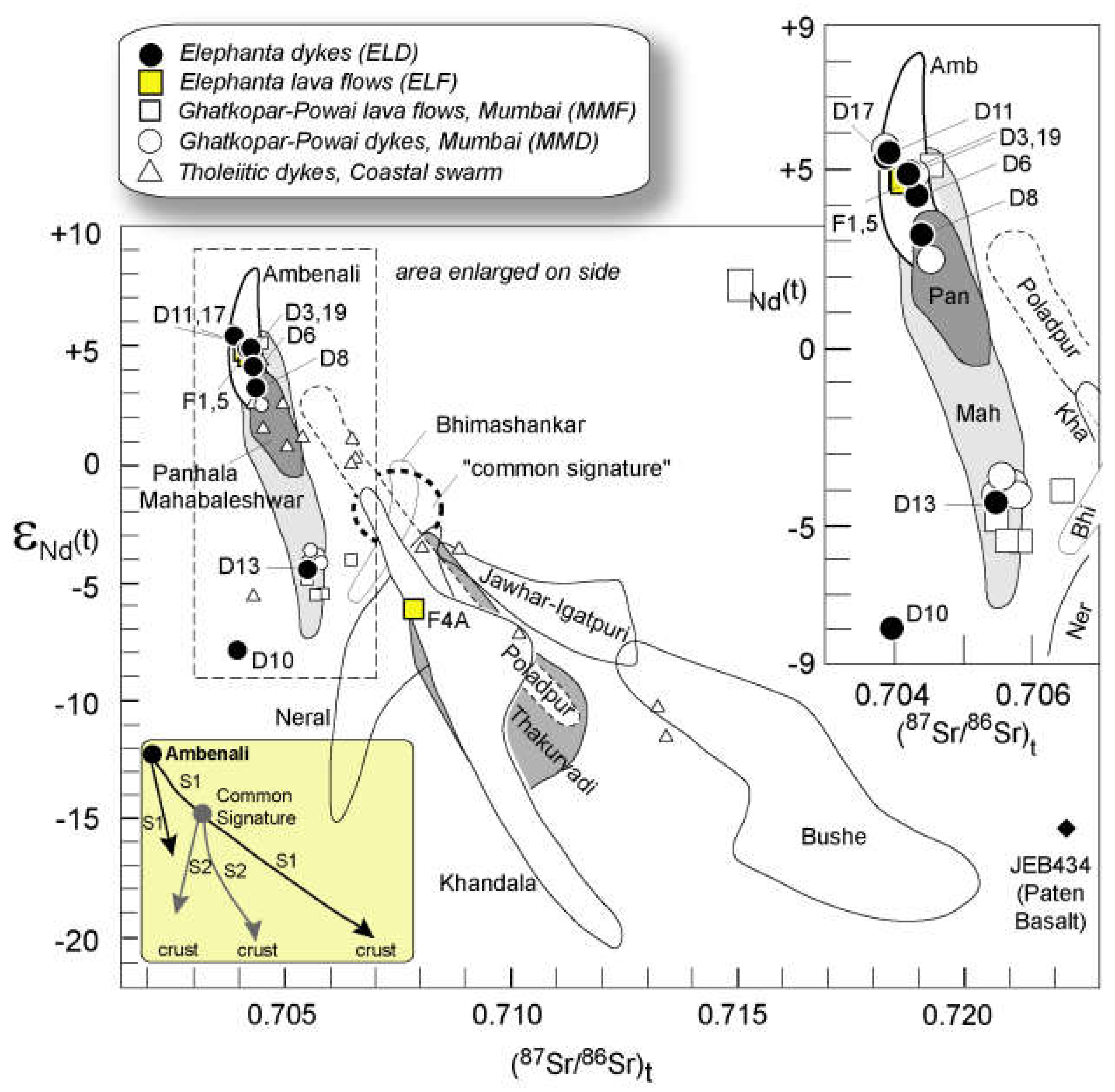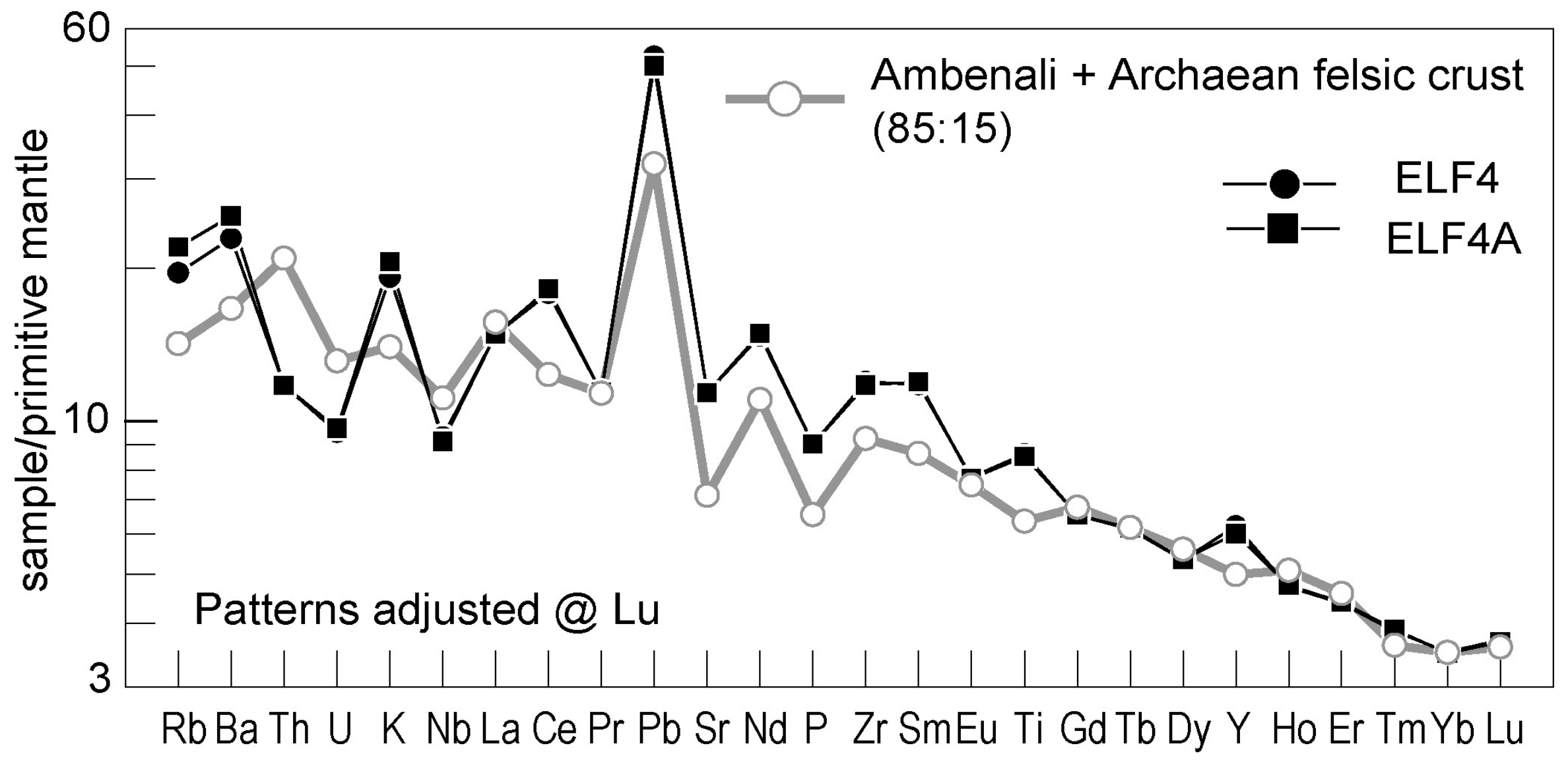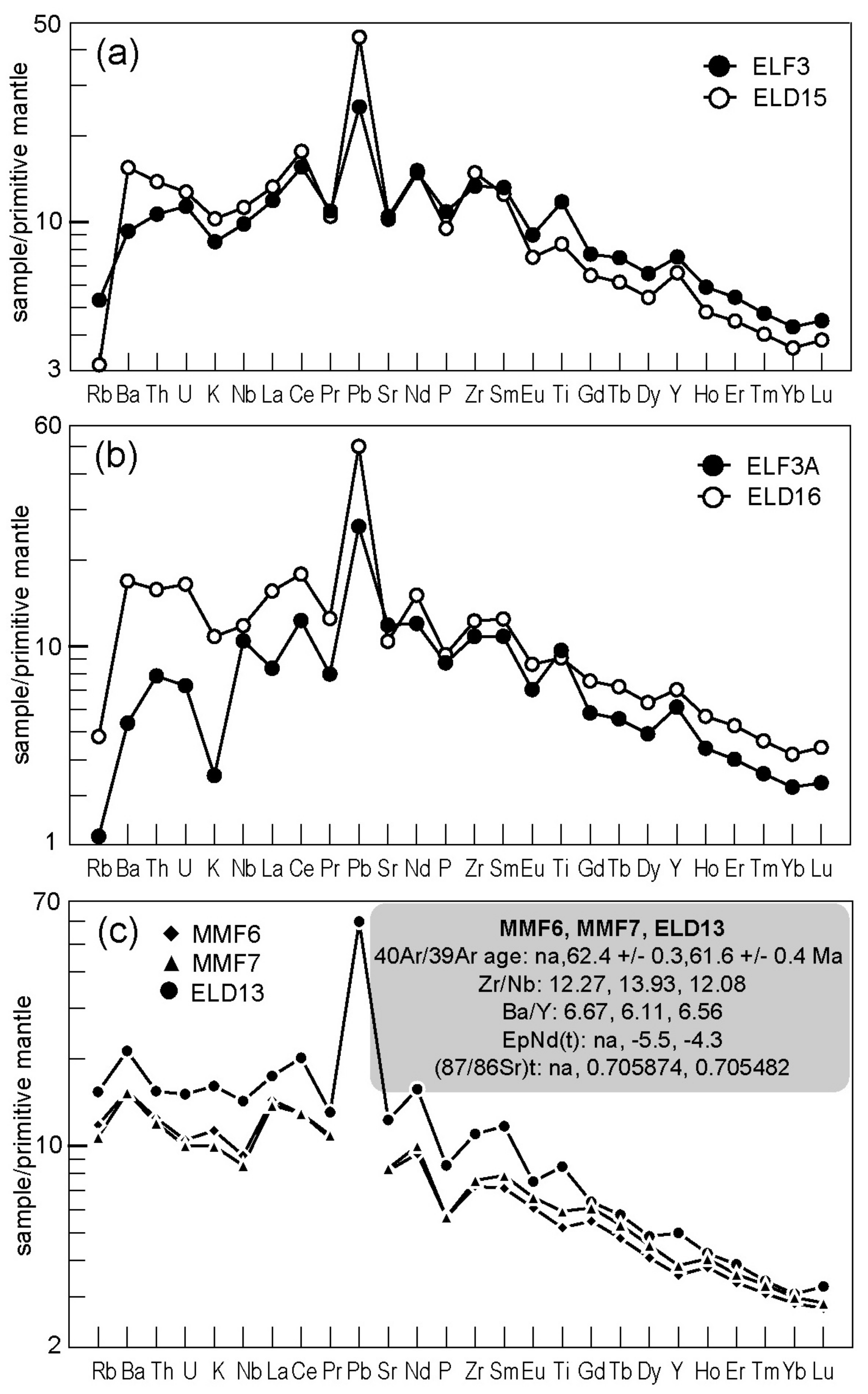1. Introduction: Flood Basalts, Rifted Continental Margins, and Monoclinal Flexures
Volcanic rifted margins [
1,
2] form during continental break-up and the birth of new ocean basins, and are associated with voluminous flood basalt magmatism (both extrusive and intrusive) and pronounced extensional tectonics. Major flood basalt provinces located on rifted continental margins are the Karoo province of southern Africa, the Paraná province of South America, the East Greenland and West Greenland provinces, and the Deccan province of India [
3,
4]. The coastal edges of these continental flood basalt (CFB) provinces show monoclinal flexure zones, in which the kilometers-thick, flat-lying flood basalt sequence of the province’s interior shows significant tectonic dips toward the newly formed ocean [
5,
6,
7]. Rifted continental margins with flood basalts thus provide excellent opportunities to study the interplay of magmatism and extensional tectonics on one hand [
8,
9,
10], and the dynamics of uplift and erosion of the rift shoulders on the other [
1].
The Deccan CFB province, presently covering ~500,000 km
2 in western and central India, was rapidly constructed at 66–65 Ma (e.g., [
11,
12]) and is best developed in the Western Ghats (WG hereafter) escarpment (
Figure 1a). Here, extensive geochemical stratigraphic work over a north–south distance of ~500 km has divided the volcanic sequence into three subgroups and eleven formations with a total stratigraphic thickness of ~3.4 km (e.g., [
13,
14,
15],
Table 1). Three major dyke swarms also outcrop in the Deccan province [
16,
17,
18,
19] (
Figure 1a), namely the ~ENE–WSW-trending Narmada-Tapi swarm in the north-central part of the province, the ~N–S-trending Coastal swarm on the Konkan Plain (the narrow coastal strip between the WG escarpment and the Arabian Sea), and the Nasik-Pune swarm with dykes of several trends in the WG region. The Narmada-Tapi and Coastal dyke swarms are the feeders of some lower and middle stratigraphic formations of the WG sequence, whereas the Nasik-Pune dyke swarm mainly fed lavas of the middle and upper formations [
17,
18,
19]. Several lava flow sequences located in the central, northern, and northeastern parts of the Deccan province broadly correlate with the WG sequence [
20,
21,
22], implying that large-volume lava flows of the WG region may have travelled hundreds of kilometers to these distant areas. The Deccan CFB eruptions were followed by the India–Laxmi Ridge–Seychelles breakup at 62.5 Ma [
23,
24], with significant Deccan magmatism occurring syn-breakup and continuing post-breakup up to ~61 Ma in Mumbai and the Seychelles [
23,
25].
The westward extent and continuity of the WG sequence are less well known because the Konkan Plain (
Figure 1b) is a structurally disturbed region, being part of the 62.5 Ma rifted continental margin [
23]. A major tectonic structure known as the Panvel flexure (
Figure 1b) is found here, in which the Deccan volcanic sequence shows a significant seaward dip with block faulting [
5,
32,
33,
34]. The island of Mumbai in the westernmost Deccan province (
Figure 1a,c) shows a compositionally diverse volcanic sequence (tholeiite, spilite, and rhyolite lava flows and pyroclastics) with mafic and felsic intrusions, dipping west at ~18° (e.g., [
35,
36,
37,
38]). The Mumbai tholeiitic flows and dykes show geochemical differences with the WG sequence [
39], and the entire Mumbai sequence is 62.5 Ma in age (Danian), as known from palaeontological evidence on inter-lava sedimentary and pyroclastic beds [
40,
41] and
40Ar/
39Ar dating [
23,
42]. The Mumbai sequence (Salsette Subgroup of [
43],
Figure 1b,c) is thus significantly younger than, and unrelated to, the WG sequence. To the east of Mumbai, in the Mumbra Hills of the New Mumbai area (
Figure 1b,c), Deccan lavas yet unstudied for geochemical stratigraphy dip very gently west (2–3°) and become essentially horizontal further east in isolated tablelands like Matheran (803 m) and the WG escarpment (
Figure 1c).
The island of Elephanta near Mumbai (
Figure 1b,c) has not yet been studied in terms of its geochemical stratigraphy. Elephanta is situated in the Panvel flexure zone in the transition between the horizontal, tholeiitic, 66–65 Ma WG sequence and the west-dipping, compositionally diverse, 62.5 Ma Salsette Subgroup on Mumbai. The Lonavala and Wai subgroups, forming the higher parts of the WG escarpment, extend westward to immediately east and south of Elephanta on the Konkan Plain [
26] (
Figure 1b), where they outcrop close to sea level, an effect of the Panvel flexure [
18]. Determining the stratigraphic position of Elephanta in the WG sequence, or its independence from the latter, is thus key to understanding the westward continuity of the WG sequence as well as structural disturbances affecting the rifted margin. Here, we present geological, petrographic, mineral chemical, and whole-rock geochemical (major and trace element and Sr–Nd isotope) data on the Deccan flood basalt lava flows and dykes of Elephanta Island. The varied dataset helps to place these flows and dykes in the WG stratigraphic sequence, which improves our understanding of the stratigraphic and structural development of the westernmost Deccan CFB province, in the Panvel flexure zone on the western Indian rifted margin.
2. Geology of Elephanta Island
Elephanta Island (
Figure 1c) has an approximately 7 km circumference, and consists of jungle-covered eastern (168 m) and western (131 m) hills separated by a ~N–S-aligned central valley (
Figure 2a,b). The island is composed of subaerially erupted tholeiitic lava flows and dykes, with no evolved or pyroclastic rocks, which is in stark contrast to the nearby Mumbai. However, the Mumbai and Elephanta sequences both dip prominently westward, the latter at 12–14° (see interpretative stratigraphic cross-section in
Figure 2b). The absence of post-Deccan basalt marine sediments on Elephanta Island (except for its modern peripheral tidal flats) suggests that the island has remained above sea level in post-Cretaceous time. Lava flow morphotypes observed at Elephanta include a 40 m thick rubbly pāhoehoe flow (samples ELF1, 2) in the southeastern part of the island [
34], underlain by a columnar-top lava flow (sample ELF1A) exposed in the intertidal zone, the two separated by a red bole. The rubbly pāhoehoe flow is traversed by two subparallel normal faults with an oblique slip toward the east [
34]. The rubbly pāhoehoe flow is overlain by compound pāhoehoe flows made up of numerous small flow units or lobes, generally weathered and amygdaloidal [
44,
45]. Due to jungle and the absence of interbeds or red boles, it is not possible to know the exact number of compound flows in the Elephanta sequence, but our samples ELF3, 3A, 4, 4A, 4B, 5, 6, and 7 (
Figure 2b) probably represent only a small number of these.
Many mafic dykes outcrop on Elephanta Island, cutting the lava flows (
Figure 2a), as does a small mafic sheet intrusion on the southeastern coast, striking N–S and dipping 45°E. Whereas most dykes are basalts and dolerites, there are also two picrite dykes (ELD9, 10) and an ankaramite dyke (ELD13). No dykes are observed to pass into lava flows, but flows fed by some of these dykes, while eroded away locally, may be preserved in sections elsewhere including the WG escarpment. The depth dimension of the dykes, where seen, indicates them to be dipping steeply east, as expected from their host lava flows dipping gently west because of the Panvel flexure. Like tholeiitic dykes in Mumbai [
23,
39], the Elephanta dykes show a strong ~N–S preferred orientation (
Figure 2a).
40Ar/
39Ar ages of 66–65 Ma [
46] on two Elephanta lava flows and six dykes (including four tholeiites, a picrite, and an ankaramite) imply that the bulk of the Elephanta sequence formed rapidly, well before continental breakup, and is contemporaneous with the WG sequence. The Elephanta sequence is probably a westward stratigraphic continuation of the WG sequence, downflexed to the Arabian Sea because of the Panvel flexure, and it is this aspect that we evaluate in this study with detailed geochemical–isotopic comparisons and correlations. The Elephanta ankaramite dyke yielded a significantly younger
40Ar/
39Ar age of 61.6 ± 0.4 Ma (2σ) than all the others [
46], showing that the total duration of Elephanta magmatism was no less than 3.5 Myr and possibly as much as 6 Myr. Interestingly, the young age of the Elephanta ankaramite dyke overlaps with that of the Powai ankaramite flow in Mumbai [
23,
39], suggesting the dyke to be a potential feeder of that flow [
46].
3. Samples and Analytical Methods
Our sample set from Elephanta Island consists of 31 samples, 11 of which (samples ELF1 to ELF7) come from lava flows and the rest (samples ELD1 to ELD20) from dykes (
Figure 2a,b); locations of the 31 collected samples (GPS-based coordinates) are given in
Supplementary Table S1. The samples are dark grey to black, they sometimes contain vesicles and amygdules, and whereas the basalt and dolerite samples are typically aphyric in hand specimen, samples of the picrite and ankaramite dykes are distinctly porphyritic in hand specimen, with abundant subrounded phenocrysts of olivine and clinopyroxene dispersed in a fine-grained groundmass. We took samples of 2–3 kg from each of the distinct rock units, taking care that the samples were representative of the sampled unit and as fresh as possible, without secondary minerals. As we had to sample many of the rock units (particularly the dykes) on the intertidal zone, not all samples are fresh or uniformly fresh. However, we cut slabs and then chips (of total weight of several hundred g) from the freshest interior parts of all samples using a diamond saw, and the rest of the rock material was stored away. The chips were washed with tap water and cleaned with distilled water in an ultrasonic bath. Chips that were ~3 cm in length were used for preparing thin sections for petrographic observations (
Figure 3), whereas smaller chips (0.5–1 cm) were used for preparing rock powders of all 31 samples.
Eleven samples of the Elephanta lava flows and dykes, covering a range of minerals and textural types, were chosen for mineral chemical analysis. Approximately 600 mineral compositions (
Supplementary Tables S2–S6) were obtained at the University of Naples, using an Oxford Instruments Microanalysis Unit equipped with an INCA X-act detector and a JEOL JSM-5310 microscope in energy-dispersive spectrometry (EDS). The standard operating conditions included a primary beam voltage of 15 kV, filament current of 50–100 μA and variable spot size from 30,000 to 200,000x magnification, 20 mm WD. Measurements were made with an INCA X-stream pulse processor with Energy software. Energy uses the XPP matrix correction scheme developed by [
47], and the pulse pile-up correction. The quant optimization is carried out using cobalt (FWHM, full width at half maximum peak height, of the strobed zero = 60–65 eV). The following standards were used for calibration: anorthite (Ca), San Carlos olivine (Mg), anorthoclase (Si, Al, Na), albite (Na), rutile (Ti), fayalite (Fe), chromite (Cr), serandite (Mn), microcline (K), Durango apatite (P), fluorite (F), barite (Ba), strontianite (Sr), zircon (Zr, Hf), synthetic Smithsonian orthophosphates (La, Ce, Nd, Sm, Y), pure vanadium and niobium (V, Nb), Corning glass (Th and U), sphalerite (Zn), pyrite (S), galena (Pb), sodium chloride (Cl), and pollucite (Cs). The Kα, Lα, or Mα lines were used for calibration, according to the element. Backscattered electron (BSE) images were obtained with the same instrument (
Figure 4).
For obtaining major element data, the small chips (~5–10 mm size) of the 31 Elephanta rock samples were cleaned in an ultrasonic bath and ground to powders of <75 μm grain size using a Retsch PM-100 planetary ball mill and stainless steel grinding balls at the Indian Institute of Technology Bombay. Solutions of the sample powders were prepared following the methods described in [
45], and analyzed for major elements on a SPECTRO ARCOS inductively coupled plasma atomic emission spectrometer at the Sophisticated Analytical Instrumentation Facility (SAIF), at the Indian Institute of Technology Bombay. U.S. Geological Survey rock standards were dissolved along with the samples, where standards DNC-1, BIR-1, BCR-2, and BHVO-2 were used for calibrating the instrument. Standard W-2a was also analyzed as an unknown to estimate the analytical accuracy. Loss on ignition (LOI) values were determined by heating the rock powders to 1000 °C in platinum crucibles, after overnight drying in an oven at 110 °C to drive away adsorbed moisture (H
2O
−). The major oxide and LOI data are presented in
Table 2, along with the reference and measured values for standard W-2a. The reference and measured values for W-2a are generally in good agreement, except for Fe
2O
3T, whose measured value is ~5% higher than the reference value, suggesting a possible small contamination effect from the steel grinding balls.
To obtain trace element (including rare earth element) data, sample preparation vials (pressure bombs) were soaked for 4–5 h in dilute HNO
3 (2–3 %), cleaned ultrasonically in distilled water, and dried. About 60 mg of rock powder was weighed into the vials and ~1.5 mL of HF-HNO
3 (2:1) was added to it. Tightly capped vials were ultrasonicated for 45 min and kept overnight on a hot plate at 65 °C. A day later, the vials were opened and dried down, though not to a bone dry condition. Then, ~1 mL of 8 N HNO
3 was added. The above process was repeated and 0.5 mL of 8 N HNO
3 was added along with a small amount of ultrapure water and the samples were left on a hot plate for a few minutes. Dilutions were made by adding 1 mL of 200 ppb Ru (an internal standard used to determine the instrumental drift) (i.e., 20 ppb Ru in 10 mL Tarson tube and 9 mL of sample solution). The contents of the vial were transferred to a 25 mL volumetric flask with multiple washings and distilled water was added in order to dilute the solution up to the mark. A large suite of trace elements including the rare earth elements (REE) was analyzed at Thermo Fisher Scientific India Pvt. Ltd., Mumbai, using a Thermo Scientific iCAP RQ inductively coupled plasma mass spectrometer (ICPMS). Standard W-2a was also analyzed as an unknown to estimate the analytical accuracy. The full analytical details can be found in V. Patel (Ph.D. thesis in preparation), and the trace element data are presented in
Table 3.
A subset of the total 31 flow and dyke samples (the three flows ELF1, ELF4A, and ELF5 from key stratigraphic positions, and eight of the largest, freshest, and petrographically interesting dykes) was analyzed for strontium and neodymium isotopic ratios at the Laboratory of Geochronology, Department of Lithospheric Research, University of Vienna. Digestion of whole-rock powders (150 mg) in a 4:1 mixture of ultrapure HF and HNO3 in tightly screwed Savillex® beakers, kept at 105 °C on a hot plate, was carried out for two weeks to ensure complete leaching of the rare earth elements (REEs). After evaporating the acids, repeated treatment of the residue using HNO3 and 6 N HCl resulted in clear solutions for all samples.
Rb, Sr, Sm, and Nd concentrations were determined from two separate sample aliquots by isotope dilution (ID) using a 87Rb–84Sr and a 147Sm–150Nd spike, respectively. The REE fraction was extracted using AG® 50W-X8 (200–400 mesh, Bio-Rad) resin and 4.0 N HCl. Neodymium and Sm were separated from the REE fraction in a second column set using Teflon powder coated with HdEHP, and 0.22 N HCl and 0.4 N HCl as the elution media, respectively. The Sr and Rb element separation followed conventional techniques using AG® 50W-X8 (200–400 mesh, Bio-Rad) resin and 2.5 N HCl as the elution media. Maximum total procedural blanks were <50 pg for Sm and Nd and <1 ng for Sr and Rb and were taken as negligible.
The purified Nd, Sm, and Sr fractions (~1 μg) were loaded on Re double filaments whereas Rb was loaded on a Ta single filament and run in static mode on a ThermoFinnigan® Triton TI thermal ionization mass spectrometer (TIMS). A
143Nd/
144Nd ratio of 0.511843 ± 0.000003 (
n = 5) and an
87Sr/
86Sr ratio of 0.710250 ± 0.000004 (
n = 6) were determined for the La Jolla (Nd) and the NBS987 (Sr) international standards during the period of investigation. Within-run mass fractionation for Nd and Sr isotope measurements was corrected for
146Nd/
144Nd = 0.7219 and
86Sr/
88Sr = 0.1194, respectively. External uncertainties on the
143Nd/
144Nd and
87Sr/
86Sr isotope ratios are quoted as 2σ errors. The Sr–Nd isotopic data are presented in
Table 4.
8. Conclusions
Geochemical (major and trace element) and Sr–Nd isotopic data on the Deccan tholeiitic lava flows and dykes of Elephanta Island, located in the Panvel flexure zone on the western Indian rifted margin, help to compare and correlate the sequence to the kilometers-thick, horizontal, and extensively studied tholeiitic sequence forming the WG escarpment ~60 km to the east. Both sequences are dated at 66-65 Ma (e.g., [
12,
46]), and geochemical–isotopic correlations suggest that the Elephanta sequence represents the western continuation of the Khandala and Ambenali formations in the WG sequence, with the intervening Bushe and Poladpur formations missing, but two flows present above the Ambenali flows that do not resemble any of the WG formations and may have been locally erupted. The geochemical–isotopic data help identify magmatic processes such as crystal fractionation and crustal contamination in the Elephanta flows and dykes. Mineral chemistry and geothermobarometry of these flows and dykes indicate low pressures of crystallization, and only small amounts of contamination, by lower continental crust, are permissible for most rocks. On the other hand, the geochemical stratigraphy helps identify a normal fault along the central part of the island with an easterly downthrow of 220 m, consistent with domino-type block faulting with easterly (landward) downthrows which is already known from the southeastern part of the island [
34] and surrounding areas [
33,
39,
88]. Considerable E–W-directed organized crustal extension is implied by the strongly N–S preferred orientation of a majority of the Elephanta dyke intrusions, some of which were probably feeders to the Ambenali Formation lavas in the WG sequence, requiring a revision in the current view [
18,
19] that the voluminous younger formations of the WG sequence were erupted without significant crustal extension. The data suggest instead that E–W extensional strain was already active at 66–65 Ma along this future (62.5 Ma) rifted continental margin. The Powai ankaramite flow in the 62.5 Ma Mumbai sequence, 20 km to the northwest, may have been fed by the young (~62 Ma) Elephanta ankaramite dyke which, along with 62.5 Ma, strongly N–S-oriented tholeiitic dykes [
23,
39] and rhyolitic lava flows in Mumbai [
42], represents continental breakup between India–Laxmi Ridge and the Seychelles [
23,
24].
